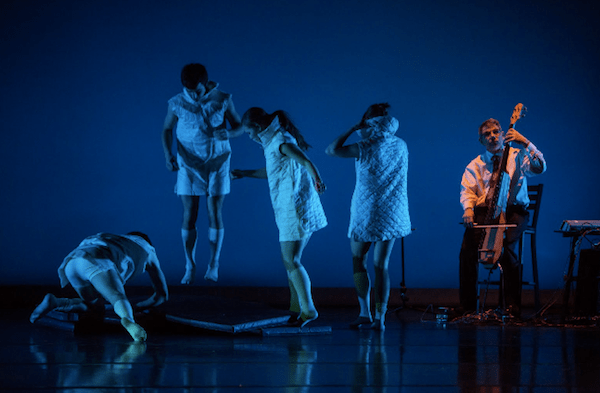
Choreographer and composer synergy in the Twin Cities
By Lydia Lui, American Composers Forum
On two wintry evenings this past March, Mathew Janczewski’s ARENA DANCES closed out their seventeenth season at The Cowles Center for Dance & Performing Arts in downtown Minneapolis with the world premiere of a new work, entitled version, commissioned by Live Music for Dance Minnesota, sponsored by the American Composers Forum, and funded through generous grants from the McKnight Foundation and The Andrew W. Mellon Foundation.
This piece represented the first collaboration between choreographer Mathew Janczewski, composer Phil Fried, and dancers Jacob Melczer, Renee Starr, Sarah Steichen and Timmy Wagner. version was a rare opportunity for all to work together in a truly improvisatory fashion, both in terms of connecting improvisatory dance to music, and improvisatory music to dance. In the words of Fried, “It was new for us all.”
Practically speaking, choreographing for improvised music, or composing for improvised dance, is a unique exercise. In a typical collaboration, “the composer is either an interpreter of the choreography, or the choreographer is an interpreter of the music.” This begs the question: Which approach did version take?
In this case, it was both. According to Fried, “At first it was [like] cracking the egg open – but once we just played with it, I think the dancers and Mathew appreciated just how flexible the sounds can be. Then it came alive. Everything happened at once or close to it.”
Prior to this collaboration, Janczweski, had heard examples of Fried’s improvisations, which draw on his experiences as a free jazz improviser with the New York Artists Collective where he was influenced by such diverse artistic voices as John Coltrane, Jimi Hendrix, Jack Bruce, Arnold Schoenberg, and Edgard Varese, among others. Janczewski was intrigued by the idea of challenging his dancers to improvise movement to abstract sounds, so he approached Fried and asked for a score composed in a similar style utilizing sounds that are mostly “non tonal, not metric and with unfamiliar memes,” as Fried describes it.
Based on Fried’s earlier improvisations, Janczweski created a blueprint, or design, consisting of several landmarks. Movements inspired by modern and traditional dance elements were suggested to incorporate these landmarks, but on the whole were not necessarily tied together. Over the course of the rehearsal process, with input from Janczweski, Fried and the company, the movements and their progression became more organic and connected. What initially began as dance structures became points of inspiration, though a few elements did remain in the final performances. The creative process was therefore an organic collaboration that, over time, morphed into unexpected shapes and forms, facilitating and encouraging a true response between all performers and avoiding all appearance of pre-determined movements executed on cue. Indeed, Janczewski’s goal was for the dancers to create movement in real time, to music created in real time, and that goal was realized.
Fried approached the work from a slightly different perspective; he sought to connect his free jazz improvisatory style with physical movement. Ultimately, his intention was not only to respond to the dancers, but also to suggest and encourage improvisatory movements. Thus at times he was reacting to the dancers, while at other times he was providing the creative spark behind their movements. To achieve greatest flexibility, Fried elected to perform alone with an upright electric bass, a Dave Smith analog synthesizer programmed with abstract sounds, and an effects box. During the rehearsals and performances, Fried combined and mixed all sounds, including improvised bass and three prepared electronic sounds (or “loops”) by means of foot pedals, and improvised in different timbres and colors, employing extensive harmonics, staccato sounds, and melodic fragments. The effect was ambient sounds and sonic sonorities, amplified and electrified, free of pre-fixed forms and structures.
So what was the end result?
At the final performances, visual movement combined with sound to form an intensely powerful experience: a highly kinetic art form of great fluidity, interaction, and expression between all performers, and a heightened sense of anticipation for those in the audience. Indeed, the melding together of the two artistic forms evoked a highly intensified experience, stimulating both the eyes and the ears. As the great composer of ballet scores, Igor Stravinsky, once said, composing for dance was like “hearing the music with one’s eyes”, or participating in “a tour of a building for which [one has] drawn the plans but never explored the result”.
For Janczewski, the experience was an exciting foray into the improvisatory process – an “unknown journey” that broadened both his and the company’s artistic horizons. For Fried, the visual elements of improvising with dance were “unique and mind blowing”; he now considers how his music might be visualized. But most importantly, together they were able to achieve an experience greater than their individual contributions. At the beginning of this collaboration, Fried sought “To achieve beauty wonder tension release surprise emotion etc. – that is theater.” At the end, that is truly what they achieved.
Recent Content
-
Artsarticle ·
-
Artsarticle ·
-
Artsarticle ·
